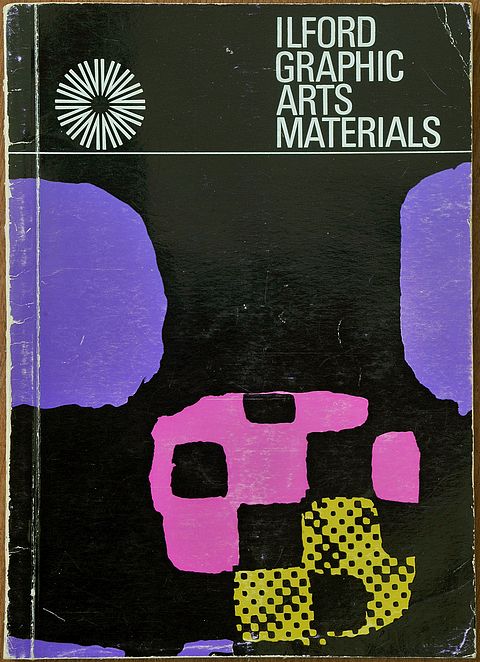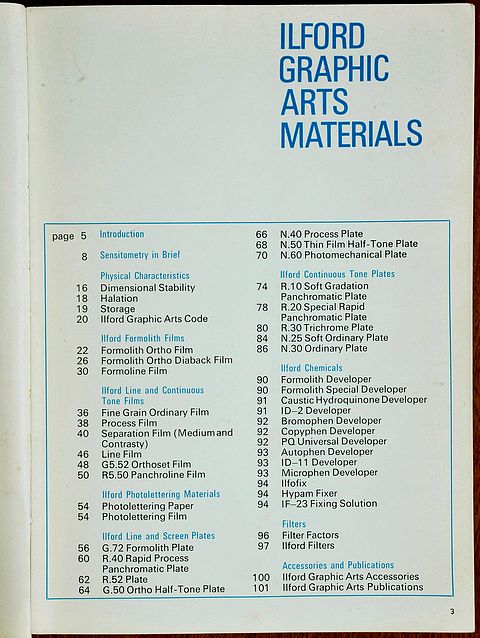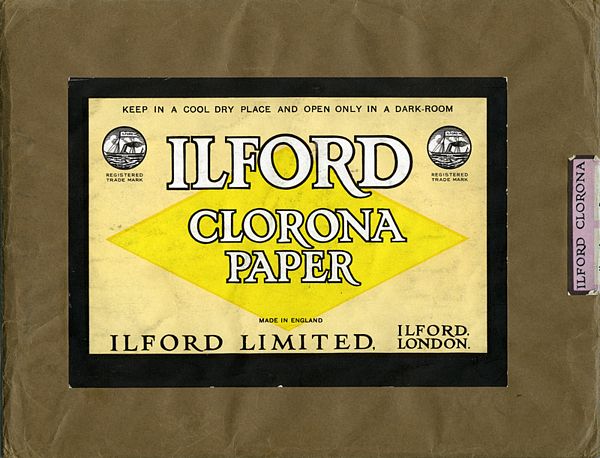| ILFORD Bromide, P.O.P and GasLight / Contact Papers |
|
|
|
|
|
The British Journal of Photography Almanc (BJPA) contained this Ilford advertisment for printing papers available at the start of 1930. To see a 1930 Ilford advertisement for Intona P.O.P. paper and an example of Intona paper packaging from around 1920, click here. |
 |
|
This Bromide Paper was first introduced in 1897. Notice that it pre-dates the change of company name to Ilford, Limited and is instead being sold by the original Harman company of The Britannia Works Co. Ltd. |
|
|
|
|
|
Michael Talbert reports that warm tones on Ilford “Clorona” paper were popular in the 1930s. The Ilford Manual for 1935 gives two print developers, ID-23 and ID-24, suitable for producing warm-black to sepia to red tones on Clorona paper. The Ilford Manual also states that Clorona paper required a negative of “Fair contrast” when brown-sepia to red tones were desired. As the tone of the print changed from brown-black to sepia and finally to red, the visual contrast decreased, so a negative of fairly high contrast usually gave the best results. This is exactly what Michael found in the 1960s using Kodak's equivalent, Royal Bromesko paper. |
|
|
These boxes have been conveniently dated (25/2/144, 23/8/43 and 25/2/44) and so were products of Ilford during World War 2. The lowest of the four boxes, labelled S.2 25P is thought to date to the 1930s. |
|
|
|
|
.jpg) The upper surface of the top box (B.1
1.P) The upper surface of the top box (B.1
1.P) |
|
| Although Ilford Bromide paper had been on sale since 1884, the box of bromide paper below is clearly much later, post-1945, since it has no Paddle Steamer trade marks. It is also a 'New Range' at the transition of Ilford' paper grading. Image by Simon Spaans. | |
  |
|
|
|
|
| Ilford Printing Out Paper (P.O.P) | |
|
Prior to printing papers like 'GasLight' (see below) and Bromide papers, prints at the same size as the original negative were produced using paper that darkened naturally when left exposed to daylight. This 'self-darkening paper i.e. not requiring a developing process, was originally known as 'Albumen' printing paper, but later became commonly known as Printing Out Paper or P.O.P. This paper was coated with Albumen mixed with ammonium chloride and silver nitrate. Albumen paper was first manufactured from the 1850s (not by Ilford) and a description was first published in 1850 by Louis-Desire Blanquart-Everard. 'Silver by the Ton' tells us (Appendix 4) that P.O.P. was first sold in 1891, a time when Ilford was known as the Britannia Works Co. and became (December 1891) the Britannia Works Co. Ltd. The date when the P.O.P packet alongside was manufactured is unknown, but since the manufacturers are clearly stated as Ilford, Limited, this implies it was post-1900. It looks to be early 20th century. Glossy Mauve P.O.P was manufactured from 1893. The 'paddle steamer' within the central 'O' is too small to confidently apply a date, though seems to be the earliest registered form of the company logo. The P.O.P (Albumen) paper was exposed to daylight via a glass negative plate, the two being held in close contact within a contact printing frame. Upper-most within the wooden contacting printing frame would be the frame's glass and beneath that was placed the glass negative plate. A sheet of Albumen paper, emulsion side in contact with the glass plate, came at the bottom of the frame and finally the wooden back of the printing frame was attached to hold the paper and negative plate firmly in contact under spring pressure. In the middle of the wooden back would be a hinge, so that part of the back could be opened to look at the image appearing on the P.O.P. without disturbing or releasing the pressure on the other part. Thus, if the image was still too light, the lifted half of the back could be hinged down again and the exposure continued without any risk of disturbing the registration between the paper and the negative. Unlike 'development' Contact paper, which was exposed only briefly to bright tungsten light or daylight, the printing frame with P.O.P was placed on a window sill facing the sun, or in strong daylight, for a significant length of time. Every quarter of an hour, or less in bright sunlight, the back of the frame was opened to check on the density of the image on the paper. When the print was judged to have the correct density, the paper was removed from the frame and placed in a bath of plain 'Hypo', aka 'Fixing', solution. 'Hypo' is an old fashioned term for Sodium Thiosulphate (Na2S2O3), originally known as sodium hyposulphate. In this bath of 'Hypo' the silver that had not been exposed to daylight and therefore had not turned grey or black during the exposure, was chemically converted into soluble silver salts that could be washed out of the paper, hence 'fixing' the image. During this 'Fixing' process, the print usually became lighter in tone and so most pictures were exposed until slightly too dark before being taken out of the printing frame and being placed in the Hypo. After the paper was washed for half an hour to an hour, most prints were then toned in 'Sepia Toner', which gave a rich brown colour to the image and also made the image even more permanent. Note, however, that the P.O.P packet shown here contained Glossy Mauve paper, presumably to obviate the need for sepia toning. |
|
|
Despite the arrival onto the of market many types (from various manufacturers) of Bromide, Contact and Chloro-bromide "development" papers, P.O.P remained available until the mid-1950s (this date applies to P.O.P in general; the specific production date range applicable to Ilford, Limited, is unknown). |
|
|
|
|
| Ilford GasLight / Contact Paper | |
|
Gaslight printing paper was a slow (i.e. relatively light insensitive) paper used for making contact prints. "Contact" prints mean prints made by clamping the negative into close contact with the printing paper, hence the resulting print is exactly the same size as the negative. Such a printing method was frequently used when negatives were large enough (plates or large roll film sizes) to produce worthwhile 'same-size' prints. But the advent of miniature 35mm film cameras mostly made such a printing method obsolete and such small negatives were printed by projection using an 'enlarger' to yield a useful sized image. The name Gas Light refers to yellow coloured light, as produced by 'Towns' gas when burnt in gas mantles for home lighting. The paper was largely insensitive to such light and so contact printing could be carried out in what was, until the 1930s, normal household room gas lighting. But the term (and the paper type) persisted into the electric light era (as with this 1940 packet), though it was necessary to take more care to shield the paper from direct light when using it in a room lit by electricity. By the 1950s, this type of slow, silver chloride based, printing paper was (correctly) renamed as Contact Printing Paper. The pack of paper shown here is of ¼ plate size (3¼" x 4¼") of Normal contrast grade, single weight (i.e. thick paper rather than card) and with a glossy surface (though requiring glazing to bring out the full glossy potential. Glazing involved squeegeeing the wet print (from its final wash) onto a sheet of glass and allowing the print to dry. With luck (!) the print would fall off the glass when dry and would have a perfect mirror glossy finish. Commercial printing laboratories used heated chromium glazing sheets rather than glass. The code on the packet is S31P, which is odd as the paper is labelled as Normal grade, while 3 usually refers to a Hard or Vigorous grade. Perhaps the 'Changes in Gradation' shown above explains the anomaly. It seems that post-1945 Ilford changed their printing paper contrast range such that the previous Grade 3 (vigorous) became named 'Normal' with a Grade 2 designation. The packet shown here seems to fall into the transition period when both grading nomenclatures were in use |
|
|
|
|
 This Selo pack probably dates from the mid-1930s and it is quite possible that the '35' in the lower right hand corner is a date mark for 1935. Image by Simon Spans. |
|
|
Further images of Selo Gaslight
printing paper (below), from this same era, have come to
me from Bob Hindley. The stamp on the back says
County Borough (of) Halifax, 24 Sep 1938, Alien's Department. |
|
.jpg) |
.jpg) |
.jpg) |
.jpg) |
|
The unopened packet of Selo
Gaslight paper shown below, 12 sheets of 3½ x 2½ inches
'soft' glossy single weight paper, was purchased by the author
at the Wolverhampton Camera Fair on 6th October 2024. Notice that it was sold by
J.Lizars, Photographic Dealer of 101, Buchanan Street, Glasgow.
It was priced 6d (6 old pence = 2.5 new pence). The J.Lizars
business appeared annually in the 'Directory of the Photographic
Trade' listed in the British Journal Photographic Almanac (BJPA)
until 1943, proclaiming various addresses including 381, Sauchiehall
Street, Glasgow, but 101-107 Buchanan Street seems to have been
their Head Office. |
|
 |
 |
| A leaflet that was enclosed with Ilford Contact Paper in August 1949 can be downloaded here. | |
|
From Michael Talbert The table was printed in the book “Selo Text Book of Amateur Photography”. There were six contrast grades of glossy single weight (code P) paper at that time and an amazing choice of paper surfaces. Below is a similar list from (believed) the early 1950s. The range of surfaces and grades had reduced by then. |
 |
|
Its likely that Multigrade samples would have otherwise been included, as with the 1955 edition. |
.jpg) |
.jpg) |
.jpg) |
| The images below
are all by courtesy of Michael Talbert. Images of the front and rear labels on boxes of Ilford bromide paper. The first are B2 1P = Glossy, Grade 2 Normal, Single Weight. Next is a box of B1 1K = Glossy, Grade 1 Soft, Double Weight. |
|
 |
 |
 |
 |
| Below are shown
the cover and index pages from the Ilford Graphics Arts book. Published by Ilford to describe the properties of all their Graphic Arts plates and films, such as base thickness, identification codes, development times and ASA (light sensitivity) speeds. The book was published in April 1967. |
|
 |
 |
|
Below: An August 1966 (H66) packet of Ilfobrom paper, Glossy, Grade 2 (Nromal), Single Weight. Right: A May 1972 (E72) packet of Ilfobrom paper, Velvet Stipple Grade 2 (Normal), Double Weight. |
 |
 |
|
|
|
|
|
|
|
||
 Bromide Platinomatt Surface paper – (‘PMS’ paper). Image
alongside, courtesy of Michael Talbert.
Bromide Platinomatt Surface paper – (‘PMS’ paper). Image
alongside, courtesy of Michael Talbert. Ilford Clorona paper introduced around 1933. Scan sent
by "David".
Ilford Clorona paper introduced around 1933. Scan sent
by "David". Ilford Bromide, Selo Gaslight and Selo
Contact paper boxes.
Images supplied by Michael Talbert.
Ilford Bromide, Selo Gaslight and Selo
Contact paper boxes.
Images supplied by Michael Talbert. A packet of 4¼ x 3¼ inches
i.e. ¼ plate size, glossy, mauve, Printing Out Paper
(P.O.P.)
A packet of 4¼ x 3¼ inches
i.e. ¼ plate size, glossy, mauve, Printing Out Paper
(P.O.P.)
 A
Selo Gaslight printing paper packet image sent to me by
Michael Talbert. He believes the packet dates to around 1940.
A
Selo Gaslight printing paper packet image sent to me by
Michael Talbert. He believes the packet dates to around 1940.